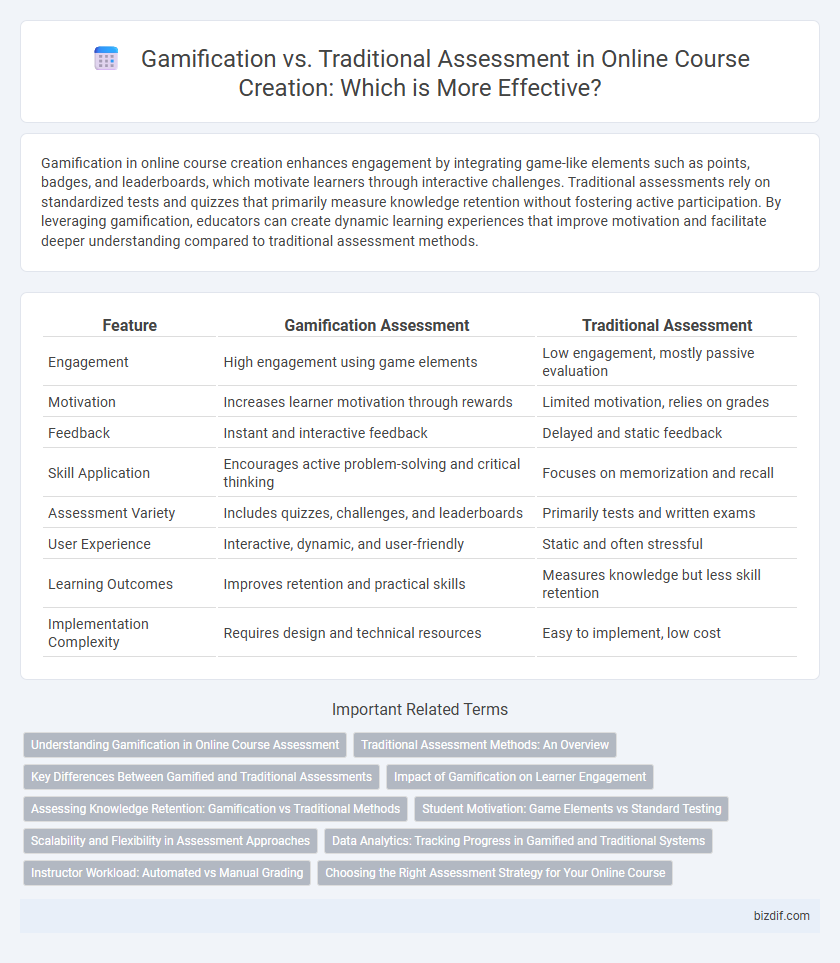Gamification in online course creation enhances engagement by integrating game-like elements such as points, badges, and leaderboards, which motivate learners through interactive challenges. Traditional assessments rely on standardized tests and quizzes that primarily measure knowledge retention without fostering active participation. By leveraging gamification, educators can create dynamic learning experiences that improve motivation and facilitate deeper understanding compared to traditional assessment methods.
Table of Comparison
| Feature | Gamification Assessment | Traditional Assessment |
|---|---|---|
| Engagement | High engagement using game elements | Low engagement, mostly passive evaluation |
| Motivation | Increases learner motivation through rewards | Limited motivation, relies on grades |
| Feedback | Instant and interactive feedback | Delayed and static feedback |
| Skill Application | Encourages active problem-solving and critical thinking | Focuses on memorization and recall |
| Assessment Variety | Includes quizzes, challenges, and leaderboards | Primarily tests and written exams |
| User Experience | Interactive, dynamic, and user-friendly | Static and often stressful |
| Learning Outcomes | Improves retention and practical skills | Measures knowledge but less skill retention |
| Implementation Complexity | Requires design and technical resources | Easy to implement, low cost |
Understanding Gamification in Online Course Assessment
Gamification in online course assessment enhances learner engagement by integrating game design elements such as points, badges, and leaderboards to motivate performance and reinforce understanding. Unlike traditional assessments, which primarily measure knowledge retention through exams and quizzes, gamified assessments provide real-time feedback and promote active learning through interactive challenges. Research shows that gamification increases student participation and improves knowledge retention rates by creating a dynamic and immersive learning environment.
Traditional Assessment Methods: An Overview
Traditional assessment methods in online course creation primarily include quizzes, essay exams, and standardized tests designed to evaluate knowledge retention and comprehension. These methods rely on objective scoring criteria, allowing for consistent measurement of student performance across diverse cohorts. Despite their widespread use, traditional assessments may lack engagement compared to gamification techniques but remain effective for benchmarking learning outcomes and certification purposes.
Key Differences Between Gamified and Traditional Assessments
Gamified assessments integrate game elements such as points, badges, and leaderboards to increase engagement and motivation, while traditional assessments rely on standard tests and quizzes focused on rote memorization. Gamified assessments provide real-time feedback and adapt to learners' progress, enhancing interactivity and personalized learning experiences. Traditional assessments emphasize summative evaluation with fixed criteria, often lacking immediate feedback and dynamic learner interaction.
Impact of Gamification on Learner Engagement
Gamification in online course creation significantly increases learner engagement by incorporating game design elements such as points, badges, and leaderboards that motivate and reward progress. This interactive approach enhances knowledge retention and encourages active participation compared to traditional assessments, which often rely on passive testing methods. Studies show that gamified assessments boost completion rates by up to 50%, making them a powerful tool for improving overall learning outcomes.
Assessing Knowledge Retention: Gamification vs Traditional Methods
Gamification enhances knowledge retention by incorporating interactive elements like quizzes, badges, and leaderboards that actively engage learners and reinforce learning through instant feedback. Traditional assessment methods, such as written exams and multiple-choice tests, often promote rote memorization but may lack sustained motivation and fail to measure practical application effectively. Studies show gamified assessments increase learner participation and knowledge retention rates by up to 34% compared to conventional testing approaches.
Student Motivation: Game Elements vs Standard Testing
Gamification in online course creation enhances student motivation by incorporating game elements such as points, badges, and leaderboards, which foster engagement and a sense of achievement. Traditional assessment methods rely on standard testing formats that often evoke stress and limit intrinsic motivation. Research shows gamified assessments boost participation and encourage continuous learning through interactive and reward-based experiences.
Scalability and Flexibility in Assessment Approaches
Gamification in online course assessment offers greater scalability by enabling automated, interactive evaluation methods that can handle large numbers of learners efficiently. This approach provides flexibility through adaptive challenges and real-time feedback, catering to diverse learning styles and pacing. Traditional assessment methods often struggle with scalability and lack the dynamic adaptability that gamified systems deliver in personalized learning environments.
Data Analytics: Tracking Progress in Gamified and Traditional Systems
Data analytics in gamified online course creation leverages real-time tracking of learner interactions, engagement metrics, and adaptive feedback to provide detailed insights into student performance and progress. Traditional assessment data primarily relies on static test scores and completion rates, offering limited visibility into the learning process. Gamified systems enable more dynamic data collection, allowing educators to identify learning patterns and optimize course content for improved outcomes.
Instructor Workload: Automated vs Manual Grading
Gamification in online course creation significantly reduces instructor workload by leveraging automated grading systems that instantly assess student performance through interactive activities and quizzes. Traditional assessment methods often require manual grading, which is time-consuming and can delay feedback for learners. Automated grading not only streamlines evaluation but also enables instructors to allocate more time to course design and personalized student support.
Choosing the Right Assessment Strategy for Your Online Course
Selecting the optimal assessment strategy for your online course requires understanding the contrasting benefits of gamification and traditional assessments. Gamification enhances learner engagement and motivation through interactive challenges and rewards, while traditional assessments provide structured evaluation via quizzes and exams to measure knowledge retention. Aligning assessment methods with course objectives and learner preferences ensures effective skill measurement and improves overall course outcomes.
Gamification vs Traditional assessment Infographic

 bizdif.com
bizdif.com